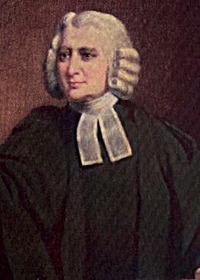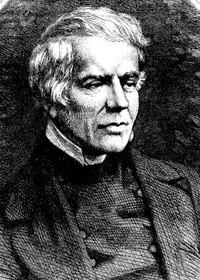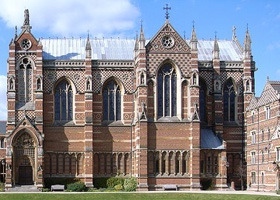
Stirring up the Faithful After the reign of William and Mary ended in 1702, the throne passed to a younger daughter of James II named Anne. Queen Anne was a generous patron of the Church and set up a fund to help supplement the incomes of the poorer clergy. When she died in 1714, however, the crown of England passed to the German House of Hanover. George I and his son George II, had both been reared as German Protestants, and had no particular sympathy for the Church of England. Under the government of these two Georges, many bishops were worldly and of questionable orthodoxy. Some were non-resident in their dioceses and indifferent toward the duties of their office. Many parish churches were in the hands of priests who were disinclined to work as pastors. Religious life sank to a low level, and in many parishes, the daily services which were customary in Queen Anne’s time were abandoned, with the Eucharist only celebrated a few times each year.
While England suffered under such conditions, two priests of the Church of England, John and Charles Wesley, became interested in religious revival. The Wesleys preached before thousands of people all across England, and along with like minded colleagues from Oxford, they spent a great deal time in preaching and teaching in jails and workhouses, as well as visiting the poor and sick. They also emphasized the importance of receiving Communion every week. In fact, John Wesley authored a book called The Duty of the Constant Communion, which encouraged churchmen to engage in frequent celebration of the Lord’s Supper. The religious practice of those devoted priests was in strict accordance with the Book of Common Prayer, and on account of this strict attention to method in their worship, they soon became known as 「Methodists.」
As the work of the Methodist element within the Church of England went on, more priests joined them, but not so many as was felt to be needed. The bishops were not very sympathetic toward their efforts and gave them little help. Because of this, lay preachers were often employed to assist in the work. When in time, some of them began to take upon themselves to exercise priestly functions, a split in the movement occurred, with Wesley supporting a traditional understanding of the ministry. In fact, he preached one of his greatest sermons against such practice. In it he said, 「in God’s name stop; be Church of England men still.」 It is known as his 「Korah」 sermon, through his allusion to a Biblical character whose story is told in the Book of Numbers. Korah could not see the necessity for the order of priesthood, and rebelled against it until it was divinely demonstrated that he was in the wrong.
Wesley also condemned the actions of Thomas Coke, a former English curate, who assumed the title of 「bishop」 when he carried on his work in America. It was the not Wesleys’ intention to to start any kind of separatist movement. Rather they sought to create a revival within the Church of England. Unfortunately due to unfavorable conditions and the indifference of the English bishops, the course of the Methodists was changed, and they finally became an independent organization.
The Oxford Movement

In 1833 there began another attempt at revival which would have a far-reaching effect within the Church of England itself. The leaders of that movement, John Keble, John Henry Newman, and Edward Pusey, were called Tractarians because of writings they published known as 「Tracts of the Times.」 This 「Oxford Movement」 aroused the interest of hundreds of students at the university. The Tractarians presented high views of the sacraments and emphasized the divine character of the Church, particularly its unbroken continuity with the primitive Church of the Apostles. They insisted on upholding the teachings of this undivided Church, and they once again called attention to parts of the Book of Common Prayer which were then being neglected.
The 「Tracts of the Times」 were published for eight years and were widely read. Many in the Church, however, were antagonistic to the Tractarians and seriously hampered their work. Because of this opposition the publication of the tracts was stopped. Newman, feeling himself persecuted in the English Church, left in 1845 to seek refuge in the Church of Rome, which was getting a new start in England after years of suppression. Though some followed his example, most of the Tractarians remained loyal to the Church of England, and a few who went over to Rome, later returned. The Oxford Movement has been described as one of the greatest revivals in all history. The tracts had aroused much interest and created a demand for better churchmanship. Many churches which in the time of the Georges had become indifferent in their religious worship now restored frequent celebrations of the Lord’s Supper, daily in many places, and the service was again conducted with great reverence.
Ritualism While Pusey, Keble, and Newman were mostly concerned with matters of theology and ecclesiology, younger generation of reformers became interested in ritual, and began to reintroduce elements of worship that had been neglected in the century prior. Vestments such as the chasuble, maniple, and stole became more common. Lights were used on the altar for the celebration of the Holy Eucharist, and church buildings became less plain, as many were decorated embellished with the rich colors of the late-Victorian era. Despite resistance in certain quarters, these so-called 「ritualists」 greatly enriched Anglican worship in the nineteenth century, and sparked what was to become a great Anglo-Catholic revival.

One of the more important byproducts of the Anglo-Catholic movement was a renewed emphasis on ministry among the urban poor. In the late-nineteenth century, the Roman Catholic Church was having great success among Irish immigrants, and the elements of ritual they used were believed to provide consolation and relief from an earthly existence that was often drab and poor. Ritualist priests combined an impressive and effective English liturgy with a genuine pastoral concern, which enabled them to build up great parishes in industrial cities like London, Manchester, and Birmingham. 「Slum priests」 such as Charles Lowder and Alexander Mackonochie were men of great sanctity whose example inspired subsequent generations of English clergy to serve the urban poor.
In 1912 an important development occurred when W.H. Knott & Son published the first English Missal. This was the rite from the Book of Common Prayer with additional chants and prayers from the Roman and Sarum Missals. This enabled the restoration of such elements as the Minor Propers (Introit, Gradual and Alleluia, Offertory, and Communion Sentence), which are brief exerpts from the Psalms used to cover movements during the course of the liturgy. It also provided readings for additional feast days and included services such as the Great Easter Vigil. A similar book called the Anglican Missal was published in 1921 by the Society of Saints Peter and Paul. This became popular with Anglo-Catholics across the English Speaking world and is used by most traditionalist Anglicans even today.